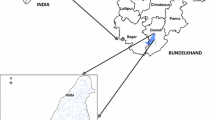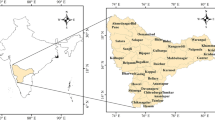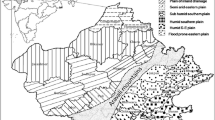Abstract
This paper proposes a methodology for assessment of drought vulnerability at spatial and temporal scales using physiographic, climatic and hydrologic factors by integrating relative influence of different factors at the scale of hydrologic response units (HRUs). In the proposed methodology, an index termed as “Integrated Drought Vulnerability Index (IDVI)” is devised as an indicator of vulnerability to drought. The SWAT model has been applied to demarcate HRUs and estimation of soil moisture in the study basin. Spatial information of different influencing factors is categorized into various sub-classes, and maps have been prepared using ArcGIS. In this analysis, monthly rainfall departure is considered as climatic factor and Soil Moisture Deficit Index as hydrologic factor. The applicability of the proposed methodology is demonstrated on the Ken River basin, located in the Bundelkhand region in central India. Using the proposed methodology, maps showing spatial distribution of relative vulnerability to drought have been obtained at the level of HRU. The HRUs with higher value of IDVI represent the areas with relatively high degree of vulnerability to drought and vice versa. The maps thus obtained have been validated using the documented information. The present methodology provides better insight for drought mitigation actions.















Similar content being viewed by others
References
Aller L, Bennett T, Lehr J, Petty R, Hackett G (1987) DRASTIC: a standardized system for evaluating ground water pollution potential using hydrogeologic settings, NWWA/EPA series, EPA/600/S2-87/035. Washington
Appa Rao G (1986) Drought climatology, Jal Vigyan Samiksha, publication of high level technical committee on hydrology, National Institute of Hydrology, Roorkee
Arnold JG, Srinivasan R, Muttiah RS, Williams JR (1998) Large area hydrologic modeling and assessment part I: model development. J Am Water Resour As 34(1):73–89
Bhalme HN, Mooley DA (1980) Large-scale droughts/floods and monsoon circulation. Monsoon Weather Rev 108:1197–1211
Blencowe JPB, Moore SD, Young GJ, Shearer RC, Hagerstrom R, Conley WM, Potter JS (1960) Soil, Department of Agriculture Bulletin 462
Byun HR, Wilhite DA (1999) Objective quantification of drought severity and duration. J Clim 12(2):2747–2756
District Statistical Handbook (1993) District statistics handbook for Sagar, Damoh, Chattarpur, Jabalpur. Directorate of statistics and economics, govt. of Madhya Pradesh, Bhopal
Downing TE, Bakker K (2000) Drought discourse and vulnerability (chapter 45). In: Wilhite DA (ed) Drought: global assessment, natural hazards and disaster series. Routledge Publishers, UK
Eastman JR, Emani S, Hulina S, Jiang H, Johnson A, Ramachandran M (1997) Application of geographic information system (GIS) technology in environmental risk assessment and management, IDRISI Project. Clark University, Worcester
Gibbs WJ, Maher JV (1967) Rainfall deciles as drought indicators. Bureau of Meteorology Bulletin 48. Commonwealth of Australia, Melbourne, Australia
Gregory JH, Dukes MD, Jones PH, Miller GL (2006) Effect of urban soil compaction on infiltration rate. J Soil Water Conserv 61:117–124
Hisdal H, Tallaksen LM (2003) Estimation of regional meteorological and hydrological drought characteristics: a case study for Denmark. J Hydrol 281:230–247
Iglesias A, Moneo M, Quiroga S (2009) Methods for evaluating social vulnerability to drought (chapter 11). In: Iglesias A, et al. (Ed.), Coping with drought risk in agriculture and water supply, advances in natural and technological hazards research 26. Springer, pp 153–159
Jarvis A, Reuter HI, Nelson A, Guevara E (2008) Hole-filled SRTM for the globe version 4, available from the CGIAR-CSI SRTM 90 m database. (http://srtm.csi.cgiar.org)
Liu MLH, Tian Q, Chen GS, Ren W, Zhang C, Liu JY (2008) Effects of land-use and land-cover change on evapotranspiration and water yield in China during 1900–2000. J Am Water Resour As 44(5):1193–1207
McColley PD, Hodgkinson HS (1970) Effect of soil depth on plant production. J Range Manag 23(3):189–192
McCuen RH, Knight Z, Cutter AG (2006) Evaluation of Nash–Sutcliffe efficiency index. J Hydrol Eng 11(6):597–602
McKee TB, Doesken NJ, Kleist J (1993) The relationship of drought frequency and duration to time scales. In: Eighth conference on applied climatology, 17–22 January, Anaheim, CA, pp 179–184
Mishra AK, Desai VR (2005) Spatial and temporal drought analysis in the Kansabati river basin, India. Int J River Basin Manag 3(1):31–41
Mishra AK, Singh VP (2009) Analysis of drought severity-area-frequency curves using a general circulation model and scenario uncertainty. J Geophys Res 114(D06120). doi:10.1029/2008JD010986
Mishra AK, Singh VP (2010) A review of drought concepts. J Hydrol 391(1–2):202–216
Narasimhan B, Srinivasan R (2005) Development and evaluation of soil moisture deficit index (SMDI) and evapotranspiration deficit index (ETDI) for agricultural drought monitoring. Agric For Meteorol 133:69–88
Narasimhan B, Srinivasan R, Arnold JG, Di Luzio M (2005) Estimation of long-term soil moisture using a distributed parameter hydrologic model and verification using remotely sensed data. Trans Am Soc Agric Eng 48(3):1101–1113
NASA Landsat Program (2003) Landsat ETM + scenes L71145044_04420000323, L71144042_04220000417, SLC-Off, USGS, Sioux Falls, 17/04/2000
Nash JE, Sutcliffe JV (1970) River flow forecasting through conceptual models part I: a discussion of principles. J Hydrol 10(3):282–290
NBSS. 1994. Soil series of India. National Bureau of Soil Survey and Land Use Planning, Nagpur, NBSS Publication No. 40, ISBN: 81-85460-20-5
Neitsch SL, Arnold JG, Kiniry JR, Williams JR (2005) Soil and Water Assessment Tool: theoretical documentation version 2005. Grassland, Soil and Water Research Laboratory, Agricultural Research Service and Blackland Research Center, Texas Agricultural Experiment Station, Temple, Texas
Palmer WC (1965) Meteorological drought. Weather Bureau, Washington DC
Palmer WC (1968) Keeping track of crop moisture conditions, nationwide: the new crop moisture index. Weatherwise 21:156–161
Pandey RP, Pandey A, Galkate RV, Byun HR, Mal BC (2010) Integrating hydro-meteorological and physiographic factors for assessment of vulnerability to drought. Water Resour Manag 24:4199–4217
Ponce VM, Pandey RP, Ercan S (2000) Characterization of drought across climatic spectrum. J Hydrol Eng 5:222–224
Price K, Jackson CR, Parker AJ (2010) Variation of surficial soil hydraulic properties across land uses in the southern Blue Ridge Mountains, NC, USA. J Hydrol 383:265–268
Price K, Jackson CR, Parker AJ, Reitan T, Dowd J, Cyterski M (2011) Effects of watershed land use and geomorphology on stream low flows during severe drought conditions in the southern Blue Ridge Mountains, Georgia and North Carolina, United States. Water Resour Res 47(2):1–19
Rose S, Peters NE (2001) Effects of urbanization on streamflow in the Atlanta area (Georgia, USA): a comparative hydrological approach. Hydrol Process 15(8):1441–1457
Shafer BA, Dezman LE (1982) Development of a Surface Water Supply Index (SWSI) to assess the severity of drought conditions in snowpack runoff areas. In: Western snow conference, Reno, NV, Colorado State University, pp 164–175
Shahid S (2008) Spatial and temporal characteristics of droughts in the western part of Bangladesh. Hydrol Process 22:2235–2247
Sharda V, Srivastava P, Kalin L, Ingram K, Chelliah M (2013) Development of community Water Deficit Index: drought-forecasting tool for small- to mid-size communities of the Southeastern United States. J Hydrol Eng 18:846–858
Slegers MFW (2008) “If only it would rain”: farmers’ perceptions of rainfall and drought in semi-arid central Tanzania. J Arid Env 72:2106–2123
Tetzlaff D, Seibert J, McGuire KJ, Laudon H, Burn DA, Dunn SM, Soulsby C (2009) How does landscape structure influence catchment transit time across different geomorphic provinces? Hydrol Process 23:945–953
Thiruvengadachari S, Gopalkrishna HR (1993) An integrated PC environmental for assessment of drought. Int J Remote Sens 14(17):3201–3208
Tsakiris G (2008) Uni-dimensional analysis of droughts for management decisions. Eur Water 23(24):3–11
Tsakiris G, Pangalou D, Vangelis H (2007) Regional drought assessment based on Reconnaissance Drought Index (RDI). Water Resour Manag 21(5):821–833
Wilhelmi OV, Wilhite DA (2002) Assessing vulnerability to agricultural drought: a-Nebraska case study. Nat Hazards 25:37–58
Wilhelmi OV, Hubbard KG, Wilhite DA (2002) Spatial representation of agro-climatology in a study of agricultural drought. Int J Climatol 22:1399–1414
Wilhite DA (2000) Drought as a natural hazard: concept and definition. In: Wilhite DA (ed) Drought: a global assessment, natural hazards and disaster series, vol 1. Routledge Publisher, UK
Author information
Authors and Affiliations
Corresponding author
Rights and permissions
About this article
Cite this article
Jain, V.K., Pandey, R.P. & Jain, M.K. Spatio-temporal assessment of vulnerability to drought. Nat Hazards 76, 443–469 (2015). https://doi.org/10.1007/s11069-014-1502-z
Received:
Accepted:
Published:
Issue Date:
DOI: https://doi.org/10.1007/s11069-014-1502-z




